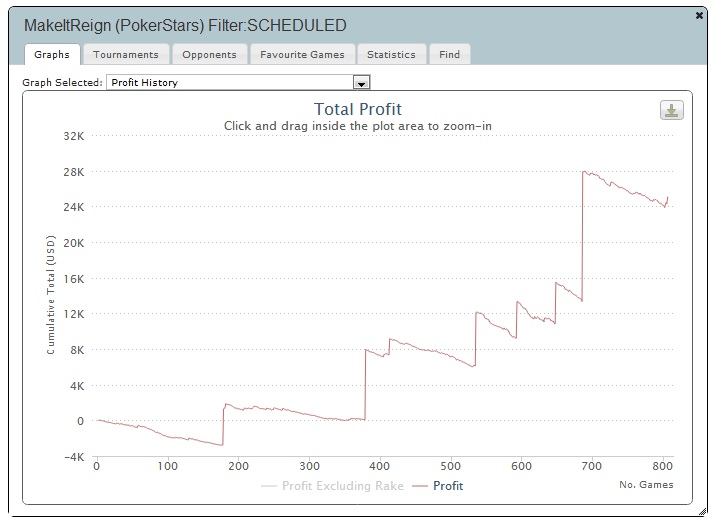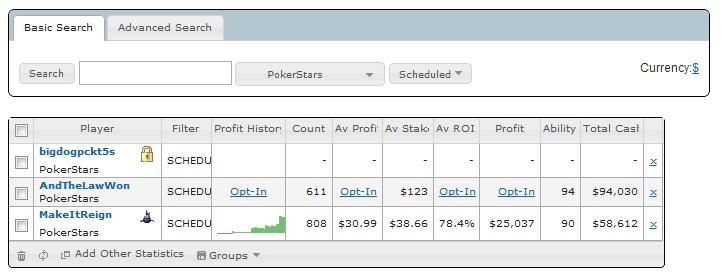Disclaimer: Using SharkScope during sessions and/or disclosing SharkScope data about other players in chat may be against some sites’ Terms of Service (ToS). Be aware of the ToS for each site that you play on in order to protect your account integrity.
Information is king at a poker table, and the more free information you can get, the better. You don’t watch showdowns in other players’ pots for your health, right? SharkScope information, when interpreted and used correctly, can be an effective tool in determining an opponent’s overall strength. Although some rooms- namely PokerStars – have restricted the use of its players’ data, the information presented by the site can help you determine your opponents’ profitability while potentially boosting your own.
When They Opt-In
When you have a subscription, and your opponents are opted-in, any data under the sun is at your fingertips. But what data is the most indicative of a player’s capabilities? Obviously, profit will be a popular answer to this question (as it should be). But profit alone is not enough to determine who you’re dealing with at a table. If you saw an anonymous player’s live tournament data in late 2009, and only looked at profit, you’d see $5.1MM and likely conclude that he is one of the most successful tournament grinders in the world – but then you’d find out that player was Darvin Moon and perhaps conclude otherwise. Profit alone doesn’t help control for “luck factors” in MTT poker, so it’s important to know what other data to carefully look at to paint a more accurate picture.

Obviously, another important piece of information will be the profit history graph (seen above). Seeing one’s profit history will give you a visual interpretation of some opponents’ characteristics that profit might not. Profit history will show you a player’s consistency – a gradual upward climb would indicate a slow consistent winner; a graph with several huge peaks and valleys might tell you that you’re playing a spaz. It might also give you evidence that a player is on a hot streak or an unusually bad run. Finally, profit history could also give you obvious visual information that an opponent had one big lucky score, affecting profitability with “luck factors.” For example, perhaps Darvin Moon’s graph would show a complete losing trend for 1,000 games and then one abrupt upswing (the Main Event runner up finish) back up into the black. This could be true online as well – a player plays 5,000 MTTs and consistently loses but then has one hot Sunday and wins the Warm Up for $150k. If you saw his profit was $120k, you might think he was a complete sicko, when it’s quite probable that the opposite is actually true.
Perhaps more important is count. As with all other statistics, a number becomes more and more statistically significant (accurate) with a larger sample size. Count in MTTs is sample size, and the larger the count, the more reliable a player’s SharkScope data becomes. A losing player through 150 MTTs is not necessarily always going to be a loser – he may just be on an unusually bad run or still adjusting to a site’s specific MTT structure (among other possibilities). There is no rigid number to use as a guide, but the bigger the count the better.
The last column I’ll focus on is Avg Stake. Average Stake gives you a players average buy in size, which will help give you an idea of that player’s experience at your tournament’s stake. If you played the Sunday Million and saw a player with an average buy in of $2.66, you could guess that player satellited in and might be out of his or her element. Also, it’s well known that high buy in players play differently than micro-stakes grinders. Knowing what a player’s average buy in is will help give you an idea of what to expect from him or her.
Note: Players focusing on MTTs will want to make sure to use the “scheduled” tab before checking opponents. Otherwise, the data sample will include Sit-N-Gos which will inevitably affect all factors, especially ROI, Avg Stake, and Count. If you’re playing mostly Sit-N-Gos, there is also a specific tab for that data as well. Either way, including “all games” is likely not a great idea since the structures and strategies between the two types vary so much.
When They’ve Opted Out
Unfortunately for SharkScope users, many PokerStars users are “opted out” and have some of their information hidden. This will inevitably affect users’ ability to view some important data, but by utilizing some simple calculations, more determined users can still make the most of this available, albeit limited, information.

Above is SharkScope data for three TPE Pros – Casey “bigdogpckt5s” Jarzabek, Jamie “AndTheLawWon” Kerstetter, and myself (MakeItReign). As you can see, Jarzabek’s information is completely locked out, Kerstetter’s is “opted out” and my own data is public. Like Kerstetter, many PokerStars players are still opted-out by default and have only a small amount of SharkScope data visible. Assuming the opt-out data is still accurate, one can still discern some important information on opponents even if they haven’t opted in. One can multiply the MTT count by the average stake in order to determine the total buy in amount (in USD). This information is important because together with “Total Cash” it can help you figure out whether or not a player is profitable – one of the major reasons players check SharkScope in the first place.
By applying the formula (Count)(Av-Stake)=Total_BuyIns, to the formula Total_Cash – Total_BuyIns, one can determine an opponent’s overall profit from MTT play. For example, AndTheLawWon’s profit would be
(611)($123)= $75153;
$94030-$75153= $18,877 profit.
Sharkscope information can be a mixed bag. In order to maximize its potential value to you, it’s very important to know not just where to look for data, but also what data to look for. Using this article as a guide is likely to be a good start in knowing your opponents.



swet1
Just FYI Stars updated their list of permitted and banned software (Sep. 20/12) and Shark Scope is now permitted including Shark Scope HUD.
http://www.pokerstars.com/poker/room/prohibited/
thedonator716
Nice article sir. I use Sharkscope quite a bit but never really thought about how to use the info for players that are automatically opted out. Thx
Liverpool015
Awesome read, in your opinion do you think its better to be opted out of a service like this?
MovesLikeDarvin
yes i would say it is. the only reason mine has been opted-in is I used to sell action on forums and wanted to be able to present data that i am profitable to users who were interested.
gigantorrr
sick read, i love sharkscope but never even thought about multiplying avg buy in by count too see if there proffitable.. thats so sick!!
also, few very subtle brags packed in there 😛
Donskey
One of the major advantages I find, is over jamming pots. If the player is ranked 8star or lower with a decent sample size that means they are really really bad.
If you’re in a pot and the fish is interested then you can sometimes over jam the pot 200+bbs even with a straight or set or whatever and they’ll call with top pair or just a pair.
I’ve been 3 bet pre flop holding AA or KK, I look at their rating and jam in level one of a tourney, and they’ll call with their AQs